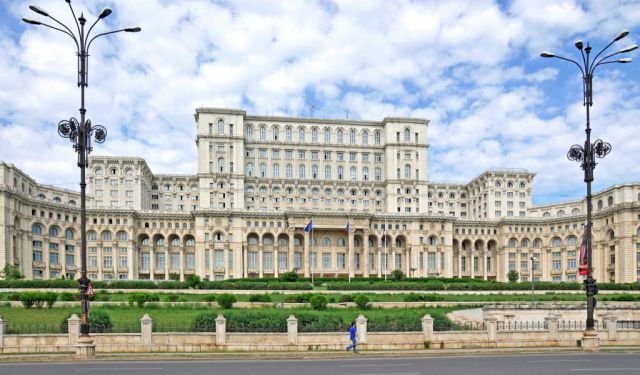Palace of the Parliament, Bucharest (must see)
The Palace of the Parliament in Bucharest is a multi-purpose building which houses both chambers of the Romanian Parliament. According to the World Records Academy, the Palace is the world's largest civilian building, most expensive administrative building, and heaviest construction. The Palace was designed and nearly completed under the Ceauşescu regime as the seat of political and administrative power. Nicolae Ceauşescu named it the House of the Republic, although many Romanians call it the People's House.
Built on the site of a hill variously known as Spirii Hill, Uranus Hill, or Arsenal Hill, which was largely razed for this mega project in 1980, the building anchors the west end of Unification Boulevard and Civic Center. Constructing the Palace and Civic Center required demolishing much of Bucharest's historic district, including 19 Orthodox Christian churches, six Jewish synagogues, three Protestant churches (plus eight churches had to be relocated), and 30,000 residences. The construction began in 1983; the cornerstone was laid on 25 June 1984.
While the building was intended to house all four major state institutions (in a similar manner to the UK Houses of Parliament), Ceausescu opted to make the palace his personal residence and have the government operate in it (as if confining the Moscow Kremlin to one building). By the time Nicolae Ceauşescu was overthrown and executed in 1989, the building had been almost complete. Some of the initially planned furnishings were never installed, and the last three basement levels and a large clock tower (meant to display the official Romanian time) were never finished.
Built on the site of a hill variously known as Spirii Hill, Uranus Hill, or Arsenal Hill, which was largely razed for this mega project in 1980, the building anchors the west end of Unification Boulevard and Civic Center. Constructing the Palace and Civic Center required demolishing much of Bucharest's historic district, including 19 Orthodox Christian churches, six Jewish synagogues, three Protestant churches (plus eight churches had to be relocated), and 30,000 residences. The construction began in 1983; the cornerstone was laid on 25 June 1984.
While the building was intended to house all four major state institutions (in a similar manner to the UK Houses of Parliament), Ceausescu opted to make the palace his personal residence and have the government operate in it (as if confining the Moscow Kremlin to one building). By the time Nicolae Ceauşescu was overthrown and executed in 1989, the building had been almost complete. Some of the initially planned furnishings were never installed, and the last three basement levels and a large clock tower (meant to display the official Romanian time) were never finished.
Want to visit this sight? Check out these Self-Guided Walking Tours in Bucharest. Alternatively, you can download the mobile app "GPSmyCity: Walks in 1K+ Cities" from Apple App Store or Google Play Store. The app turns your mobile device to a personal tour guide and it works offline, so no data plan is needed when traveling abroad.
Palace of the Parliament on Map
Sight Name: Palace of the Parliament
Sight Location: Bucharest, Romania (See walking tours in Bucharest)
Sight Type: Attraction/Landmark
Guide(s) Containing This Sight:
Sight Location: Bucharest, Romania (See walking tours in Bucharest)
Sight Type: Attraction/Landmark
Guide(s) Containing This Sight:
Walking Tours in Bucharest, Romania
Create Your Own Walk in Bucharest
Creating your own self-guided walk in Bucharest is easy and fun. Choose the city attractions that you want to see and a walk route map will be created just for you. You can even set your hotel as the start point of the walk.
Bucharest Introduction Walking Tour
Bucharest, the capital and cultural center of Romania, is one of the largest cities in Southeastern Europe.
The name București has an unverified origin. Tradition links it to the guy named Bucur, who (according to various legends) was either a prince, outlaw, fisherman, shepherd or a hunter. The Romanian word “bucurie” means joy (happiness), which in turn explains one of Bucharest's... view more
Tour Duration: 2 Hour(s)
Travel Distance: 3.7 Km or 2.3 Miles
The name București has an unverified origin. Tradition links it to the guy named Bucur, who (according to various legends) was either a prince, outlaw, fisherman, shepherd or a hunter. The Romanian word “bucurie” means joy (happiness), which in turn explains one of Bucharest's... view more
Tour Duration: 2 Hour(s)
Travel Distance: 3.7 Km or 2.3 Miles
Old Town Walking Tour
The Historical Center of Bucharest, or the Old Town, as the locals habitually refer to it, is one of the most beloved and attractive areas in the Romanian capital. The neighborhood is really beautiful a place to visit, and you can walk into it pretty much from anywhere in central Bucharest. Ion Constantin Brătianu Boulevard crosses the historic heart of the city from Piata Universitate... view more
Tour Duration: 2 Hour(s)
Travel Distance: 1.9 Km or 1.2 Miles
Tour Duration: 2 Hour(s)
Travel Distance: 1.9 Km or 1.2 Miles
Useful Travel Guides for Planning Your Trip
16 Uniquely Romanian Things To Buy in Bucharest
Nicknamed "Little Paris", today's Bucharest is the capital of a vibrant European nation, known as Romania, with lots of history and great cultural heritage - spanning from centuries-old rural traditions to New Wave cinema. Keen on rustic stuff, Romanians carefully preserve their...






